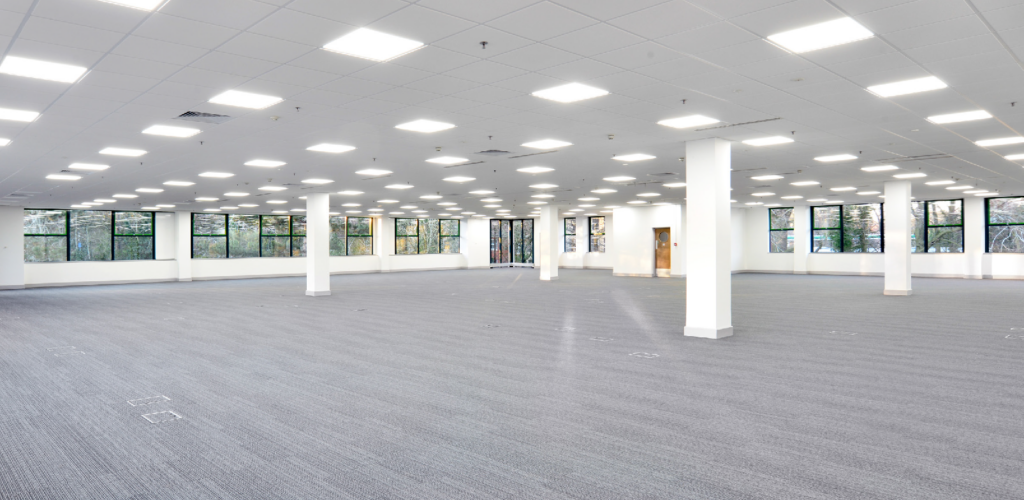Download the article here or read below. With special thanks to Karen Whitt, President of Colliers U.S. REMS.
Commercial buildings – especially the kind with vacancies that never recovered from the COVID pandemic – are typically the gold standard of construction. They’re built to serve as bustling homes for dozens of different businesses and deliver the comfortable, quiet, reliably accessible workspaces we have all come to expect. And in a way, that is the problem their owners face today: it’s difficult to imagine them as anything else.
Since Robert Propst and Herman Miller designed the modern office in the 1960’s, the format has developed its own life and culture. Cubicles served as the battleground between Peter Gibbons and Bill Lumbergh in 1999 and another bleak cubescape was Neo’s virtual prison in the Matrix. Everybody from Nerf to Terry Tate have so effectively memorialized the office zeitgeist that the thought of putting any tenant in them that doesn’t issue keycards inconceivable. But a building is just a building and we need to rethink our notions of what goes where.
If you asked an asset manager to describe a perfect storm in 2018, it would probably look something like a pandemic followed by recession, inflation, and global armed conflict that all motivated people to work remotely. Relief likely won’t come from the next generation, either. As Generation Z has largely entered the workforce during this upheaval, their preferences vary. Only 29% prefer to work fully in-office, with nearly half preferring a hybrid approach, according to Nikki Greenberg, who discussed the matter at BOMA’s Fall 2023 Future Trends meeting. Rather than finding the right tenant mix, many are just looking for lessees that can keep the lights on.
 Andrew Steele
Andrew Steele
Only 29% [of Gen Z] prefer to work fully in-office, with nearly half preferring a hybrid approach, according to Nikki Greenberg, who discussed the matter at BOMA’s Fall 2023 Future Trends meeting.
To say the modern office isn’t designed to do anything else may be an understatement. Decades of strong demand for office space has tailored every step of the process – from drawings to zoning and CAM – for traditional office users. Even their locations have often been chosen because of their niche suitability. They are tucked away in areas that don’t attract passers-by and pedestrians. In northern Virginia, for example, a secluded retail bank on the ground floor of a small suburban office building is now occupied by a bike shop and a brewery (the vault remains as a showroom feature). The upper floors have become home to an academic testing center. The owner leveraged the property’s co-location with a popular bike path and ample parking to re-zone and attract the new tenants. Although it isn’t realistic for everyone to have similar strengths, solutions will likely need to be highly specific. While apartments typically won’t fit the same space an accounting firm once occupied, market conditions dictate some alternatives will emerge.
The idea that a commercial space must be more than one thing is not new. Speculative industrial construction is typically designed to be modular and useful to a wide array of space users. The same goes for most retail spaces; even some types of offices follow a residential floorplan. The modern white-collar office building, though, has been easy to keep filled with standard white-collar tenants. Law firms, brokerage houses, SaaS businesses and everything in between need space to interact, meet clients, and foster collaboration. The same predictable nature that made them ideal occupants also made them the first to go home during the pandemic and is proving to be the most stubborn demographic when it comes to returning to city centers. With very few downsides to remote work for many, the spaces they once occupied sit dormant or see a small skeleton crew. Leases reflect it. Business want smaller spaces if they even plan to sign a traditional arrangement at all. Some firms have chosen to move entire divisions remote. One survey conducted by Digital.com in 2021 found that more than two thirds of businesses had closed some or all of their office space since March 2020 . A Harvard Business review study also showed the total reduction of office space to be between one and two percent, on average, and that it was largely the result of density reductions.
One to two percent seems inconsequential but the problem is quite a bit more complicated. There’s almost 100 billion square feet of office space in the USA according to the Energy Information Administration. To put that in perspective, estimates put Amazon’s US warehouse footprint at around 319 million square feet. Frustratingly, those losses are concentrated in unpredictable ways. Some city centers, like San Francisco, have suffered dramatic vacancy rates that trickle-down across sectors . As office workers stay home, businesses that catered to them are forced to shutter. Nightlife soon follows and then tax revenue. In short order, police can find themselves with a very difficult job to do in areas that once hosted concerts and valets. This “urban doom loop” as Stijn Van Nieuwerburgh, professor of real estate and finance and Columbia University has coined it, has not struck in the slow-motion train wreck way that troubles him yet, but signs are growing that it could be on the way.
Other areas that have relied on proximity to thriving industries, like the entertainment industry in Los Angeles or financial mavens in New York, have suffered more sporadically. Even there, immunity is reserved for assets with unique positions like historic landmarks or property that is important to be seen in rather than work in. Without a consistent set of symptoms or “qualifying” conditions, a single regulatory solution to the issues the real estate economy is facing is impractical. The best option is to give property owners as much latitude as possible in filling space.
 Andrew Steele
Andrew Steele
Without a consistent set of symptoms or “qualifying” conditions, a single regulatory solution to the issues the real estate economy is facing is impractical. The best option is to give property owners as much latitude as possible in filling space.
Rather than highlight how bad the problem could get, owners and regulators may do well to focus on identifying tools they could use to combat it. Some fundamental realities of commercial construction prohibit obvious repurposing ideas like apartments. One New York real estate consultant that works around the world faces the same challenge everywhere: the rehabilitation required just to meet the regular needs of residents and achieve code compliance, like plumbing for basic conveniences, is so costly that it makes more sense to demolish and start from scratch. Other uses lend themselves well to the space, though. Service-based retailers that require in-person transactions like spas and consumer financial services, may thrive. Stephanie Chon, the entrepreneur behind Virginia-based Balian Springs, worked with a family member to open a three-story spa in a space previously occupied by the SEC. She described the project as challenging but it has been open and year and she may have unintentionally started paving the way for like-minded pursuits other places. What the first-movers may do is define a set of guidelines for followers to use in crafting their leases and estimating adaptations. If successful, the once-stoic towering structures we’ve associated with the power players of the economy may become small microcosms of the economy.
Union Bank Tower in Portland, Oregon is looking at a possible future as a data center and Farm to Zero is investigating the suitability of Chicago’s Burnham Center, across the street from City Hall, for use as a vertical farm for tomatoes and herbs. In other places, every type of business from breweries to media producers and pet care is being considered for vacant suites. The robust construction quality of these spaces, while difficult to fully re-engineer, makes them ideal for experiments like these. They can easily hold up to the foot (paw) traffic and heavy-duty equipment tenants need, even boasting high capacity electrical grids and data connections to further expand the possibilities. Most are at least co-located with mass transit or have their own parking that provide ample capacity for all but the most highly-attended events. The possibilities are endless: consider a steakhouse with a 20th story view of the city, a rapid prototyper that caters to high-end clients in the aerospace industry, or even climate-stable storage, micro-startups, and boutique retail operations. The list is practically endless.
Arlington, Virginia has embraced the idea. Bolstered by the purchasing power of the people and businesses in the Capitol’s shadow, their Commercial Market Resiliency Initiative aims to ease the zoning and permitting process for these entrepreneurs. They have published guidelines for ghost kitchens, zoning ordinance amendments and published the findings of a conversion commission they charged with examining the paths ahead. This lets developers and lenders understand where the county plans to relax regulations and by how much. Other cities may be wise to follow suit. By testing tenancy ideas on existing property, the industry also gets an unparalleled opportunity to study their options without the sunk or opportunity costs associated with them under normal conditions.
There’s no crystal ball. The economy has defied expectations and continues to adapt to current events. Some businesses have shocked employees and demanded at least partial, if not full, return to the office. What could happen is anybody’s guess, but there’s good money behind the idea that use cases aren’t fixed.
For more information, please contact Tim Allison, Executive Vice President, U.S. REMS at tim.allison@colliers.com.



 Anthony Shell
Anthony Shell

 Aaron Jodka
Aaron Jodka Michelle Cleverdon
Michelle Cleverdon